Editor’s note: Lovefraud received the following email from a reader called “Adelade.” Her previous posts are “When life ain’t fair” and “This is the time for me to learn who I am.”
Having grown up in a dysfunctional alcoholic environment, I spent just about 35 years involved in one “program” or another, and I was able to strongly identify with my “inner child” after one particularly grueling session with my counseling therapist. I could clearly see how my emotional development had been abruptly arrested during my childhood, and that I had developed into an adult whose every decision and action had been based upon the need for acceptance, validation, appreciation, and approval. Fear of “dysapproval,” “dyslike,” and abandonment were, among other things, the driving force throughout my lifetime.
Last week, when the discussions were flowing from new LoveFraud readers to the long-timers, I saw in myself a step-by-step process of healing that directly reflected that philosophy of nearly all 12-Step Programs, from addictions to co-dependency. I mean, isn’t that pretty much how we all were duped? We were addicted to trusting someone else with our very lives?
So, long before I made the discovery about the exspath, I had begun teaching myself how to speak and think “truthfully.” Speaking “truthfully” translates into plain, honest, no-sugar-coating speech. If I learned how to speak the truth without malice, perhaps I wouldn’t be such an easy target for sociopaths.
I digress. Back to the spur-of-the-moment 12 Steps of Recovery from LoveFraud:
Step #1: We admit that we had involved ourselves with a sociopath and that our lives had become a living hell.
What I believe that this meant was recognizing the glaring Truth: whomever the sociopath that we are involved with might be, we can no longer ignore the absolute fact that we have been used, abused, damaged, and discarded. It is a fact. It is a Truth. And, it cannot be denied if we have found our way to LoveFraud.com.
Step #2: Make the decision to sever our toxic relationship.
We have realized what we were associated with and we have made the choice to save ourselves, our finances, our sexuality, our system of beliefs, and our very souls. We have made the conscious, cognizant, and lifesaving decision to end the toxic association, for our own sakes.
Step #3: Admit to someone who “gets it” that we had been in a dire situation and need help.
Whether that “someone” is a counseling therapist, attorney, abuse hotline intake worker, or the “family” that we have on LoveFraud.com, we make the choice – the conscious decision – to reach out through our tears, our terror, our horror, our fears, and our despair and grasp the hands of Life. We need help – we need help – we need help because we do not have the tools and techniques to survive our experiences on our own.
Step #4: Recognize that we are a part of a Greater Universe.
When we are just beginning to survive our sociopath experiences, we tend to follow human nature and become quite self-absorbed. We believe that our experiences were the worst that could ever happen to anyone. Until, that is, we read stories like OxDrover’s, Witsend, Darwinsmom, Donna Andersen’s, and others. Yes, our pain is real, and the earth is still going to spin on her axis regardless of our agony. Whether we choose to place a “spiritual perspective” on this, or not, is strictly a personal choice.
Step #5: Agree to maintain NO CONTACT for the remainder of our lives.
Now, I realize that there are many of us who share custody with a sociopath and, for that reason, “No Contact” is a very difficult rule to self-impose. Well, for those of us who do NOT have children with a sociopath, stop trying to make sense. Stop trying to “talk” to them. Stop pretending that they’re speaking the truth. No river of tears, no impassioned pleas, no personal sacrifices, and no amount of money will ever “fix” what ails a sociopath. They will not care about your pain. They DO not care about your pain. And, they never HAVE cared about you. This Truth is a fact, and it is irrefutable.
Step #6: Make amends to all people that we had harmed, directly or indirectly, as a result of our sociopath entanglements, except when to do so would injure them, or others.
Yes, we were victimized. And, yes”¦.we never asked to be victimized. But, we must look beyond our own damages and recognize that our friends, family, and inner circle experienced collateral damage, as well. We’re not apologizing FOR the sociopath. We are apologizing that the sociopath exists. Do we use the word, “sociopath?” We’re not qualified, but we sure as hell can say that they “fit the profile OF a sociopath.”
Step #7: Recognize our own frailties, vulnerabilities, and boundary failures and made efforts to repair and forgive ourselves for our mistakes.
The topic of “forgiveness” is a volatile one. There seems to be no grey area – either you forgive and heal, or you don’t and you stagnate. I disagree with both views. Forgiveness of “Self” is a moral, ethical, and emotional imperative. We were targeted, lured, and hooked by an organism that feels no empathy or remorse for damages that they create. We are not at fault with the exception that we trusted such a thing. So, we must forgive ourselves, FIRST. All the rest will come as it does, or not.
Step #8: Engage in open, frank, and truthful discussions about our experiences, how we were affected, and how our issues affected others.
Speaking about what happened to us, how it happened, and how it affected our friends, family, coworkers, and the rest of our inner circles is a part of the healing process. We speak truthfully and openly, but we keep in mind that “other people” often “don’t get it” because they have not experienced it themselves, or they are in denial. And, we are not responsible for anyone else’s issues but our own. We speak using facts – my counselor provided me with a sanity-saving mantra: feelings are not facts.
Step #9: Make every human effort to educate ourselves and others about the healing processes of sociopath entanglements.
By “educating ourselves,” I mean that we memorize and ingrain the Red Flags, and the Yellow Flags of sociopath behavior. The mechanics, studies, and statistics are utterly meaningless with regard to the healing process. And, the steps of our healing processes are not bound by a specific timeline. We must experience our healing and speak of our positive steps even as we re-examine how we were duped.
Step # 10: Allow ourselves to experience the grieving process in a healthy, productive way.
There are stages of grieving, whether it’s grieving the loss of a loved one, kicking a substance addiction, or losing the illusion that a sociopath has fabricated. We must be willing to identify and experience those stages with courage and acceptance. It’s OKAY to be angry! It’s OKAY to be sad! It’s OKAY to feel despair! But, we have to grab ourselves by our shorthairs and drag ourselves forward – nothing within the human condition prepares us for the carnages of sociopath entanglements. It is OUR time, now – our time to heal, to realize our own potential, to realize our own value, and to take our place as advocates for ourselves.
Step #11: Remain accountable for our own actions and decisions.
We can look to our sociopath experiences and say, “This is what happened to me and why I lost everything that I ever had.” What we cannot truthfully say is, “Because I was victimized by a sociopath, I am going to make stupid choices, bad decisions, and harm other people in my anger.” We may not excuse bad behavior on bad behavior. If we are wrong, or we’ve harmed another person (deliberately, or unintentionally), we stand accountable. It is not a mortal sin to be human. It IS “sinful” to refuse to acknowledge our own humanity.
Step #12: Continue to maintain our boundaries, NO CONTACT, and support and encouragement for ourselves, and for others.
We do not alter our boundaries on a person-by-person-basis. Our boundary failures are what allowed the sociopath into our domain, in the first place, and we may be wiser, but we will likely be hyper-vulnerable – more so than the “average” person. NO CONTACT is non-negotiable, even in situations of shared custody. We do not speak to the sociopath unless it involves the immediate safety/security/well-being of the shared child. All others are non-entities – they do not exist – they are not among the living – they are, in essence, deceased. We encourage ourselves AND others regardless of what our own issues might be. Through support and encouragement of others who are unfortunate members of the Sociopath Survivor Club, we are healed as we assist others in their healing processes.
So, that’s what it is, I guess. For whatever reason, I ran down the list of 12 Steps to the best of my recollection and attempted to put a LoveFraud.com spin on them. In writing these out with their explanations, I’ve taken another centimeter forward on my healing path.
I thank Donna Andersen, OxDrover, Mel Carnegie, and each and every one of you on this site for helping me along. We’re all going to push through our experiences at our own speed. And, may you each find the most sincere blessings of comfort on your own healing paths.











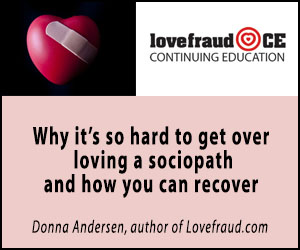



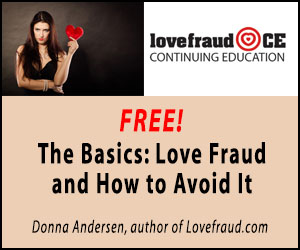





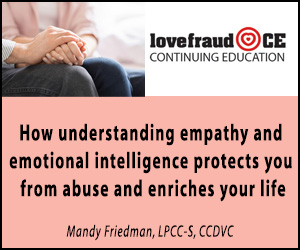






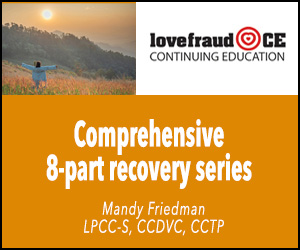
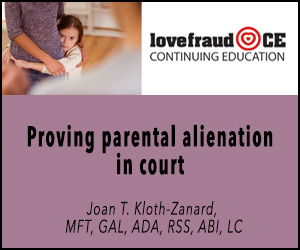


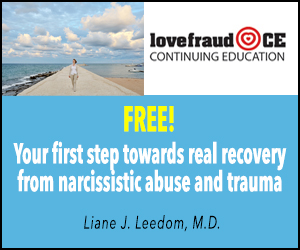
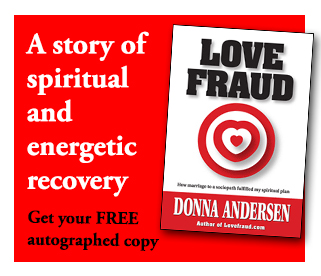
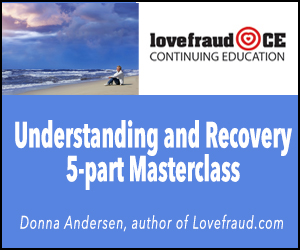
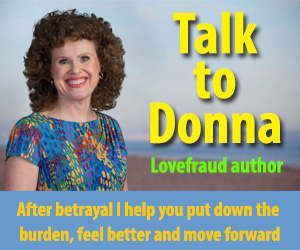
I really respect your approach to 12-steps! These are also similar to the 12-steps of SLAA: Sex/Love Addiction Anon.
I too have been in and out of 12 step programs for much of my adult life. I read somewhere that:
Beneath every addiction there is a codependent–somebody who (like myself), through no fault of our own, enabled the addict’s behavior. That’s what the program says.
What I think is a little different. Rather than focusing on the addict, this recovery is based on what I want in life. It is based on making choices now, rather than allowing a sociopath to make choices for me, which I used to allow.
One of the programs (for families of alcoholics) has the BEST brochure. It’s called “Detachment.”
It has helped me through many, many dark times. Both my parents died of alcoholism and other addictions. Everybody in my family is either an active addict or a codependent, like me.
If I can toss that term, codependent, which has become a rag-tag term at best, and just think: what do I want in this world? And, how can I detach myself–however I need to do that (but they say “with love”)—from people who cause me too much pain (sociopaths)–then, I might just have a good chance of living my own life, rather than having it lived for me. It’s taken me all my life to get just to this point, finally. Peace.
thanks,
P.S. When I said beneath every addict is a codependent, what I meant was: every addict, when you peel-away all the levels of addiction–IS a codependent first. I believe that.
Addicts use substances, people and things (like work) to numb themselves and stave-off feelings. Sociopaths use people to do the same.
Codependents focus on addicts to avoid loving themselves.
This has been my own healing. To know this on every level, including spiritual. That’s a different onion!
I think the spiritual level that I’m talking about is like Step 12. “Having had a spiritual awakening…”
Dear Adelade. Thank you for the 12 steps. The analogy with addiction is spot on.
And THANK YOU for the “Feelings are not facts”!! That was what drove me crazy all these years. The feelings I got wrong and mixed it with the facts. A real big A-HA-Moment! Thank you!
Frontporchtalker1:
This whole co-dependency thing is interesting. So the controlling alcoholic can actually be co-dependent? Sometimes this confuses me. Answers please?
Louise: A definition of co dependency:
http://en.wikipedia.org/wiki/Codependency
Does anyone know how to stop hating yourself? I realize that I repeatedly allow myself to get into relationship/friendship with narcissists and it’s because I have loathed myself since before I was a teenager and I’m going to turn 40 this year. I feel like I am a failure at everything and it seems that no one can convince me otherwise. This is me acknowledging what my problem is and I don’t know how to fix it.
Elizabeth Bennett – sometimes we stop doing an action when we understand, and sometimes we understand when we stop doing the action. I would suggest nc with all the narcs and spaths in your life – including family, if need be. if you stop engaging with people who will hurt you/ hate you, that is self care. it’s an important tennent of self love.
I’m not too thrilled about Step Nine.
I want to live my life. I have other things I want to do. It’s not my job to rescue the human population from Ps.
Back From the Edge – I clicked on the link you provided. The description bothered me enough that I clicked on the “Talk.” A lot of people are not happy with the way co-dependency is described there. There are better places to learn about it.
Co-dependency is not a term officially used by AA or Al-Anon because it is a therapy term. Al-Anon talked about being a co-alcoholic at one point. Members might use “co-dependency,” because the term has become mainstream, but it did not originate with AA. Officially, therapy terms are greatly discouraged in Al-Anon and you will not find them in any of its Conference Approved Literature (CAL.) I assume that is the same for AA.
The reasons are
1. there is disagreement among professionals as to what the terms mean
2. most people do not have professional training with appropriately applying the terms
3. people unfamiliar with the terms may feel intimidated with a vocabulary outside of their reach
4. they may also not return because they feel excluded because others seems to know and they feel foolish asking, and
5. people impose their own definitions because they think they know what the tems mean, confusing matters even more.
To keep things simple and to be as meaningful to as many people as possible, therapy terms are not used.
Yes Liz, apparently the key is to stop comparing yourself to other people. That’s what Girardian Theory says. Its easier said than done because we do this naturally as human beings. It’s how we create our identity.
Like, I can say I’m average height –compared to other women in my country.
I can also say I’m fat –compared to all the skinny models in the magazines. But if I go to walmart…suddenly, I’m thin! lol!
Just about everything used to describe me is with respect to something else. We use references like that in order to put things in slots, create organization etc…
That’s a good thing when we’re young and our brains are chaotic, still forming. Once we get older, we need to have a solid identity that has nothing to do with comparison to others. We have our values (hopefully instilled by good parents and a good culture -HA!) and our identity is all about what’s important in our lives.
Some of us, raised by narcissists are a bit slower to figure out what’s important to us. We’re still looking around to see what makes OTHER people happy. If they’re happy they must have the SECRET to happiness, right?
So when we compare ourselves to others, we don’t go around looking for people with dour expressions on their faces. We look for people who seem to have that happiness. They attract our attention with their happy smiling faces. Then we proceed to compare ourselves to them. We can never measure up. We can never BE them. That makes us feel inadequate and unhappy with ourselves. If we hadn’t compared ourselves to them in the first place, we wouldn’t feel that way. The dissatisfaction begins when we first decide to look to others for a model to compare with.
What I’ve just described is what most people do for a period of time in their lives. Eventually we grow up, but in the mean time, we do have some sense of identity and some values.
Spaths don’t have any identity or values at all. Everytime they compare themselves to happy people, they feel envy and malice. They become envious because they are so completely empty and without any values or sense of being, that the comparison is devastating. I can see how it would seem unfair to them.
Spaths are a different animal altogether, but we can learn from them because they are so extreme in their disorder.
For the rest of us, I think that the book, The Happiness Trap, explains it pretty well. Decide on your values and choose to live each moment in accordance with them.